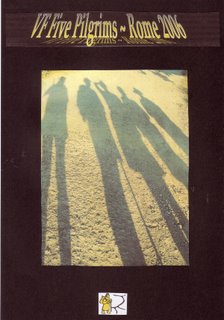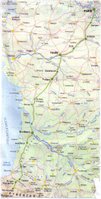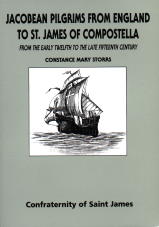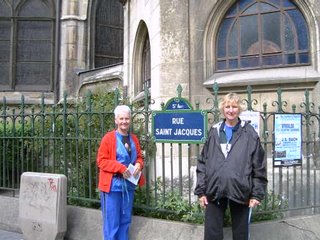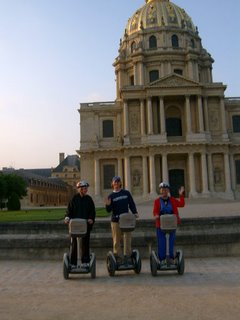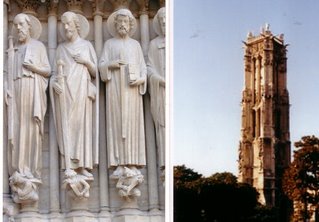13th May: After a comfortable night in a beautiful old Youth Hostel in Orleans, a fellow at the youth hostel told us we could walk along the river al
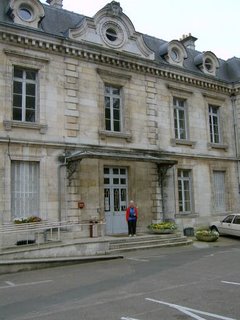
l the way

to Beaugency rather than go on the road. It was supposed to be about 25km away. The track was a pleasant surprise as the route followed the river Loire on a small footpath. The only problem was that there were no signs, no people, no towns or villages and we didn't know how we would know when we reached Beaugency. After about 25kms we came to a no entry sign on a locked gate and had to double back to find the road. We finally reached the medieval bridge of Beaugency after walking ± 38kms.
The following day we decided to walk on the road – a supposed easy 27kms to St denis-Sur-Loire, which ended up being 32.8km after all the detours through villages etc., In St Denis-sur- Loire we stayed in the La Villa de Medicis, a B&B which was built in 1852 as a hotel.

In Amboise we stayed in a Youth Hostel again. We visited the old quarter and the Châteaux Royal Amboise, the most important Royal Castle on the Loire and the centre for French kings from the 15th and 16th C where Leonardo deVinci lived and died. The next day it was 29oC and it was a rather long, hot 27kms to the northern outskirts of the city of Tours. People were interested in our flags and our shells and some gave us thumbs up knowing that we were Santiago pilgrims. Passing through Tours we visited the Cathedral of St Gatien, an important stop for pilgrims in the Middle Ages and the first statues of St James we had seen so far.

* From Sorigny to Dange St Romain the road was dead flat and straight and cut through acre after acre of wheat fields. Every now and then w

e could see jets streaking across the sky leaving long white smoke trails. It was very hot again and after about 30kms I decided to do something I had never done before – hitch a ride! I told Joy to put her thumb out and at first only I had my thumb out. No-body stopped. Then Joy nervously put her thumb out too and eventually an elderly man stopped and let us get in the back of his old car. The following day we had a short walk of about 20kms to Chatellerault, much of it on a cycle track next to the road, where we had booked into a Formule 1. We visited St Jacques church - the one with the famous statue of St James as a pilgrim festooned in scallop shells - where we got a lovely welcome and a

‘tampon’ (stamp) from the lady in the Cure office. The next day we walked 28 kms to Poitiers. We had to walk on the busy National road with heavy trucks rumbling down on us and when we reached the Futurescope I decided that we had to find a departmental road to walk on instead. After walking over and under the national road a few times we asked at an industrial park for directions and a very kind lady, Catherine Monet, got a map of the area and showed us how to follow the river to Poititers. (I told her that I would remember her to the Saint in Compostela and wrote her name down in my book). We then walked another 2kms around the hilly town visiting the 4th C Baptistry of St Jean, the Notre Dame Le Grand and St Peter’s cathedral. A very kind lady showed us where to wait for the bus to the hostel which was about 3km out of town.

20th May: At first the road took us through a lovely cool forest on the N11 but by 10 o’clock we were back in the open and it was as hot as ever. Every town we passed through seemed to be deserted. We found out afterwards that it was a bank holiday so they were having a long weekend. After 7 hours of walking we were relived to see the sign for Lusignan (pronounced Lucy-yawn) but the main road carried on forever through a closed and deserted town and after another 4kms we finally reached the de Chapeau Rouge (the Red Hat) hotel on the very outskirts of the south side of town. When we almost collapsed into the foyer, the owner took one look at our red faces and ushered us upstairs to our room where we fell on the beds and didn’t move for an hour. After a hot bath and a cold Coke we were able to walk around the little town to see the 12th C church of Notre Dame.

It was at least 34km to Melle and after 25 kms and we were bushed so we decided to put out our thumbs again. A nice young man gave us a lift but took us 2kms past the turnoff so we had to slog it back to Melle. The Hotel Les Glycines was half way up a hill and we were very grateful to relax once we had checked in.

22nd May: Today I got a blister (I don't get blisters!) and I limped into Aulnay after 30+kms. The Hotel Donjon was very upmarket and once we had checked in we visited the info office and the church of St Pierre, the best preserved Romanesque church in France. I bought a copy of a 1648 map of the Chemins de Santiago. We explored the donjon before going back to the hotel.
23rd May: A short day today – only 18kms to St Jean D'Angely. We found the Hotel de la Place and checked in and then joined in the Sunday mass at the Abbey for ± half an hour.
24th May: Only 18kms today but the Formule 1 we had booked in Saintes was another 4km out of town on the South side. When we asked a couple of policemen in the centre of town where the Formule 1 was they told us it was much too far to

walk there – at least 3km away! So we still had to slog our way to the industrial area southwest of the town. We checked in, rested and then got a bus back into Saintes where we visited the churches and crypts of the Jacobean pilgrims as well as the amphitheatre built by the Romans.

25th May: The next day was very hot and we walked the 21kms into Pons on the N137 road. A very busy road with hardly any shou
lder for walking. We booked into the Hotel Bordeaux and then went to visit the old town. Pons has a large Donjon - medieval tower - that looms above the town and an ancient strategic
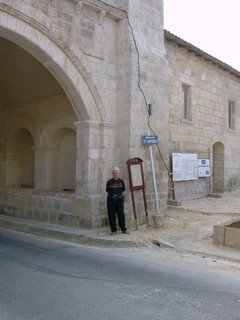
wall above the river. We climbed right to the top of the tower on a concrete spiral staircase that made one dizzy! We visited the old pilgrim hospice that arches over the main road into Pons. We got our stamps at the info centre and they wouldn’t let us pay to visit the museum because we were pilgrims. We watched an audio-visual, interactive presentation on the history of Pons. We were exhausted and after a dinner of cheese rolls for we were asleep by 9pm.
26th May: The lady in the Tourist office told us not to walk on the N137 to Mirambeau as it was not safe. She said to rather take the Chemins St Jacques trail which is very well marked with scallop shells on concrete 'steles' along the way. 'It is only 25kms' she told us. The first stele we came across after walking about 2km out of town said '31Kms' to Mirambeau and pointed straight onto a path between a wheat field and a vineyard. So we climbed through head high vegetation, grass so high tha

t we had to frog march with high knees to get through, wobble along stony paths through vineyards and past farmer's barns and through a Stainbank like forest. Then we walked through hard, lumpy recently ploughed grounds, through field after field. Not one person, no villages, no signs, no shops, just ploughed fields. 33kms to Mirambeau. We were pooped when we finally arrived at about 3.30pm and for the first time were both GAT VOL of Chemins signs and fields! Our hotel, the L’Union, wasn’t going to open until 5pm so we sat at a café-bar for over an hour and a half having ‘sandwich’ and coke and shooing away the flies.

27th May: We left Mirambeau in drizzle and had to stop to put our rain suits on for the second time. Took a charming farm road that wend its way through small farms and homestead, but after about 14 kms Joy was taking strain and had no Oomph left. We decided to get a bus so we sat in a little café in St Creer having two glasses of hot chocolate and raisin croissants for an hour before catching a bus into Blaye. We walked through Blaye to the Tourist office where we got a tampon. We then discovered that the Gite we were going to stay in was 3kms out of the city - on the road we had just walked in from and so we had to walk back to St Martin Lacaussade. When we arrived there I telephoned Mme Defosse to open the Gite for us. It had a little room with two double bunks, a kitchen with stove and an en suite bathroom. It was wonderful not to be in a hotel. We were able to recharge our batteries at the Gite as we washed all our dirty clothes, made a cup of tea and sat outside in the sun airing our feet. I cooked us a dinner of pasta and vegetables. When we left we put a donation of €10 each in an envelope.

28th May: There was thick mist when we left St Martin to walk back to Blaye so I hooked the little red flicker onto Joy’s sternum strap and she led the way. While we were waiting we took off our backpacks and rested our walking sticks against the railings. My precious ‘stokkie’ clattered under the railings and slipped through a mesh cover into the river. I was so shocked to see it fall that for an instant I was ready to jump in after it. We met three men from Belgium on bicycles who were riding to St Jean with backup before starting on the camino from St Jean-Pied-de-Port. We took the 7.30am ferry across the Garronne which took about half an hour to get to the other side and walked about 25kms to the outskirts of the city of Bordeaux. We were staying in a district called Eysines, southwest of the city, so we took a bus to Eysines. We still had to walk almost 5km to our hotel the Les Alizes. The Manager there had worked in South Africa and was quite pleased to tell us about his time there. We shopped at a little Supermarket down the road and had yoghurt and chips for supper with chocolate for desert. I also bought Isotar energy drink – the first energy drink we had seen so far.

29th May: We caught the bus to Bordeaux centre and walked down to the river and saw the large passenger ships. We found an Internet cafe in Bordeaux and after typing for over an hour the whole page vanished and I had to start again. We treated ourselves to a quiche and coffee at a sidewalk café then visited the church of St Seurin, which has a carving of St Jacques, and the Cathedral of St Andre and church of St Croix. Joy found a sex shop with her name outside and we took a photo to send home. Many churches, Abbeys and other religious monuments were destroyed during the wars of religion, the 100-year wars as well as during the revolution and the 2nd World War so there are not many Jacobean monuments left. We are always thrilled to find St James in a church or signs of the scallop shell along the way. We were going to get a modern tram to Gradignan ( yeah – Graadiyawn) south of Bordeaux, but the line was faulty so we had to take three busses to get there instead. The driver of the second bus hopped out at the stop to check that we were at the right place and told us which number to catch. (I wrote his name down as “G” Bus Driver, so that I could remember him to the Saint). Waiting at the stop for the 3rd bus a man in a car stopped and mumbled to us in French about going with him to his Château for the night. Just as I was trying to tell him where to get off the bus arrived and we hopped on. When we got to the hotel Balladins, no one was there so we let ourselves in through a side-door and I went to the kitchen and found a young man to book us in. The manager then came and said that he had actually had to turn down our Internet booking but as I had a letter of confirmation, he would honour it. He put us in a room with a kitchenette. Across the road was a shop like Macro so we bought square bread, fruit and yoghurt and had a feast in our room.
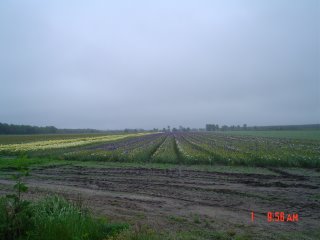
30th May: We had a bad night; it was noisy and neither of us could sleep so at 10pm we got up to make hot chocolate. It rained in the night and we had to wear rain suits all the way today. Got lost leaving the hotel and ended up walking 1½ hours on the wrong road but in the right direction. It was 29kms to Le Barp and we didn’t have a room booked so we didn’t know if we would have to walk further or sleep in a bus shelter. The first hotel we came across was the Hotel Resnier. Luckily they had a room for us and we also had a very smart lunch in dining room served by young men in white jackets and black Basque berets.
31th May: The fellow at the hotel said that we could walk all the way to Le Muret on the ‘la petit’ road so we took his advice and followed the smaller roads. When the small road joined with the National road we took a forest road and followed it all the way to a truck stop on the side of the road. A young lady told us to continue on the forest road to Saugnet et Muret. We didn’t realise that these were two different places so headed for Saugnet instead of Muret. We had to double back and cross over the main road to reach Le Muret and ended up doing 30kms instead of the planned for 23km. The hotel was quite large and we ha

d a nice room. I read in the CSJ guide that we could get the key for the St Roch Chapel from a white house in the village. The fellow in the house phoned his wife who met us on her bicycle. Another couple wanting to visit the Chapel in the woods joined us. We asked the receptionist at the hotel to call ahead to Labouheyre for us and book us a room at the Hotel Bremontier.
1st June: It was drizzling again this morning as we made our way to Labouheyre. Following the smaller roads meant that we walked 32kms instead of 25km – what’s new? (We now had about 40kms in the bank). The hotel was quite old and gloomy and the wooden floors sloped in two directions under the bed. There was a portable shower in the corner and a washbasin but the toilet was down a very dark landing with lights that switched on as you approached them. If you weren’t quick enough they would switch off before you got there! We decided to have a meal in the hotel as the Menu for the day was only €10 – salad, steak or chicken, and then an English cake with cream or ice cream.

We didn’t have a reservation for the next town so the hotel owner phoned ahead for me and booked us into a hotel in Rion-de-Landes. After dinner we went for a walk and found that there was a ‘Garre’ – a railway station just around the corner from the hotel. We decided to get a train to Morencx and then walk the last 15kms to Rion-des-Landes the next day.
2nd June: When we booked our tickets for the next station, the stationmaster was a little confused. I don’t think many people bother to catch the train to the next stop. We got the 7h30 train to Morencx. Joy was dying to use the loo so when we got off the train we tried a door at the station but found that it was actually a private home. The lady of the house came out to see who had opened the door to her lounge and we explained that we thought it was the station and that Joy needed the loo. Then her husband came and shouted to her to let Joy use their loo so Joy went inside and used their loo. Morencx was a beautiful little village. People were preparing for a market and we were quite disappointed that we couldn’t stay for it. We pushed on to Rion-des-Landes through never ending forests of pine trees. In a clearing, I saw a small deer hopping through the bracken. A squirrel scampered past us on the road and into the forest further down. The Hotel le Relais des Landes was clean and comfortable.

We found an Internet facility and sent this email home:
· We have walked over 600kms so far; an average of 28.5kms per day. Pretty hard with a heavy pack and some difficult terrain.
· We have slept in 21 different beds in 13 hotels, 2 Forumule 1;s, 4 Youth Hostels, 1 B & B and 1 Gite. The B&B was the most expensive at E64.
· We have had lunch at 3 cafe-bar-restaurants and dinner at 2 : Lunch costs ± E10 for a sandwich and dinner cost us E20 ; Coke cost E1.50 and a coffee or hot chocolate E2 ; We buy bread, cheese, fruit, yoghurt and chocolateand eat on the road or in our rooms.
· We’ve only had three rainy days the rest being bright and hot.
· The French people have been very helpful and even if they cant talk the language we manage with hand signals and my little dictionary.
· We have been picked up twice - once by a drunk man in Poitiers whoinsisted that he was a catholic and wanted us to have tea at his house (so he said !) and the other time was by a man in a car who muttered about us sleeping in a châteaux but we opted for our hotel instead. The route so far has been flat with the exception of Poitiers which itself was a hilly town.
· The wild flowers have been spectacular and the gardens are all very beautiful ; even the smallest gardens have roses and iris, delphiniums etc.
· We have seen different bird varieties and a hare hopping back to its burrow under a bridge. There have been dead hedgehogs on the roads at regular intervals and today I saw a deer in the forest on the way to Rion des Landes.
· I have used my sleeping once when I was cold in a Youth Hostel and once I stuffed it into my pillowslip to make a pillow. They give you bolsters to sleep on and its difficult to share one in a double bed!
· Joy has lost her sunglasses and her gloves and had a few near misses with Wally (her Digi Walker) I have lost a plastic fork, my sharks peak and the other day my precious walking stick with the Coast to Coast and Caminobadges on it slipped from the railings at the wharf and into the river Garonne when we took the ferry from Blaye.
· I have had blisters on my little toes, on the bump of my right foot and a big, nasty one on the heel. I think I’ve used over

20 Compeed plasters – most of them ending up sticking to my socks!
· We’ve taken 46 photo so far including one of Joy standing outside JOYS SEX SHOP in Bordeaux waiting for it to open ? · We have watched Knight Rider, the Weakest Link and Charmed in French on TV as well as some tennis and CNN when available.
· We’ve only met 4 other pilgrims so far. One Austrian with a big white beard on a bike near Orleans but he was going in the wrong direction and then 3 Belgium’s on bikes on the Ferry. They are cycling to Compostella buthave a car as back up.
· We’ve been to so many churches and cathedrals so far that we have lost count - from the grand Gothic St Andre’s in Bordeaux to a quaint little Chapel in the woods in Le Muret dedicated to St Roth and his dog. It has a 3rd Century bell tower and wooden scallop shells in the altar.
· We have 23 stamps in our credential passports including one from Notre Dame in Paris.
· We have got 5 days left walking in France and then we cross the Pyrenees into Spain at Roncesvalles. Then our Spanish adventure begins.
We still haven’t decided who is going to drive the car with it’s left hand drive on the wrong (right) side of the road !
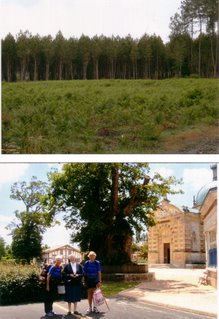
3rd June: We agreed today that a 32km walk was going to be too far in the heat so we thought we would get a bus to Buglose, about 22kms away, and walk to Dax from there. Joy woke up with a sore neck and no oomph but the bus timetable told us that the first bus was at 1pm so we decided to walk first and get a bus later. “We’ll have breakfast at Boos”, we thought, as it was the first village we would come to. Ha! We walked into Boos and out the other side in about 10 minutes flat. No restaurant, no shop, nowhere for breakfast. We ended up walking all the way through the forests to the within 6kms of Dax. At St Vincent De Paul, on the outskirts of Dax, the timetable in the bus shelter told us that the next bus into Dax was at 2pm so we visited the complex that includes a small farmhouse where St Vincent was born as well as the huge 19th C Basilica and other religious buildings. Everything was closed, even the toilet. We sat on a bench in the shade to have the last of our drinks and some dry bread with Camembert cheese. Suddenly we saw a nun approaching. She clapped her hands and shouted, “Pelerins! Oh, pelerins.” She insisted that we stay for coffee and went off to return with a flask and two plastics cups and sugar. Sister Theresa asked us where we would spend the night and was most upset when we said in a hotel in Dax. She rushed off with Joy to find a stamp pad to stamp our passports. We had our photo taken with

her and then had to leave to get our bus. (I wrote her name in my book to remember to the Saint). The bus driver was in a dreadful hurry as he had passengers on board who had to catch a train. We had a ten-minute bus trip and stopped right outside the station close to where our hotel for the night was situated. After checking in we walked into Dax centre and visited the tourism office and the cathedral and ended up walking 39km today after all. A very kind lady there phoned ahead for us and booked us a room at the Hotel Basque in Bidache. Then we visited the market, the cathedral and the old town. We had seen a Laundromat on the way into town so we collected our clothes from the hotel and spent the next two hours washing and drying nearly all of our clothes.

4th June: We didn’t sleep well because mosquitoes kept us awake and the man in the next room snored and farted all night. We had a long lie in – till 7am - and went to the station for breakfast; a very disappointing croissant and jam again. We then got the 09h30 train to Lourdes. We found the town of Lourdes to be a Mary and Bernadette Disney World with hundreds of souvenir shops selling trinkets and items with Mary or Bernadette’s faces on them. There were almost as many hotels as there were shops and a constant stream of large luxury busses bringing tourists and pilgrims jammed the narrow main street. Once we crossed the river, however, we left Disney World behind and found ourselves in the relative calm of the Lourdes complex of religious buildings and the Basilica, which was built over the grotto where Bernadette saw the vision of the Virgin Mary. We stood in the queue to enter the grotto and touched the walls as we walked through. We filled our bottles with holy water to take home. We got a stamp in our books at the administration office. We visited the church and then we went back into the village to have lunch. The owner of the restaurant had done the Camino 8 years before and he allowed us to leave our packs in the restaurant so that we could walk around the town. Our train left at 4pm and we arrived in Peyrehorade an hour later. Joy had motion sickness on the train and had a torrid 15km walk up the hills to Bidache. Our hotel was very elegant and we had a

lovely bath and an early night. We went to bed with no supper.
5th June: The 28kms to St Palais the was VERY HOT - in the 30´s - and hilly. We found the Hotel du Midi in a square. It was closed but I had the code for the front door so we let ourselves in. We made a meal of pasta and veggies in the room and then I visited a pilgrim museum set up by a local doctor who has devoted his life to researching the camino in his area. There didn’t seem to be anyone else staying in the hotel besides us.

6th June: The people of St Palais partied in our square into the early hours of the morning so we woke up feeling a bit bombed. There didn’t seem to be anyone else staying in our hotel and once again we didn’t know what to do with the money for the room when we left so I put it in an envelope and hid it behind the counter in the reception. We found our way onto the right road and immediately started to climb a long gentle slope. The terrain was undulating now and some of the hills were quite steep. It was very hot again. We were supposed to stay in Ostabat the next day but it was a deserted, tired looking place with lots of flies

. We stopped for a coke and met a couple of German pilgrims and a couple who were also walking Les Chemins de St Jacques but with a car back up that carried their backpacks. We decided to walk on to Larceveau and I phoned ahead to book a room at the hotel. When we arrived we walked to the first hotel we saw and a busy lady showed us up to a room. We only found out afterward that there was another hotel in the village and we were not in the one I had booked! We had lunch in the hotel and sat at the same table as a young couple with a young child. We were soon chatting and drawing pictures and I allowed the little girl to draw a tattoo on my arm. Her name was Manoe Mata and I wrote he
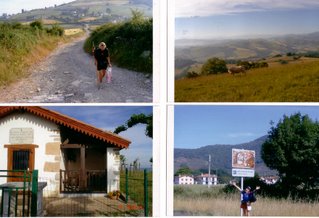
r name in my book to remember to the Saint. I walked into the little hamlet after lunch leaving Joy to watch the French Open tennis on TV. We had a much quieter night than the night before.
7th June: The following day we climbed over the mini-Pyrenees up to the Chappelle de Soyarza where we could see almost all the way to Spain. We walked to St Jean Pied de Port – hot, hot, hot - where we saw lots of other pilgrims for the first time. We had our photo taken with a group of children outside the St Jacques gate and then found our way to the the Amis St Jacques office where they tried to persuade us to walk the
Route Napoleon to Roncesvalles. We visited the museum and decided to push on to Arnegy or Valcarlos instead of tackling the long climb to Roncesvalles the next day.

Joy was worried about the difficult climb up to the Ibeneta pass (from about 160m to over 1050m in just 26kms) so we decided to go on to Valcarlos which is about a third of the way up to the pass. We battled on, finally doing 34.5kms that day. I must just say here that my feet looked a mess! I had a blister on my big toe right near the start of our walk. Then blisters under the toes next to the little toes. Then three watery buggers above the hard part of the right heel. This one was now one big blister and I had to treat it with Compeed and strapping. Up hills are not so bad but down hills seem to put pressure on the blister and make it sting like hell. Then the Compeed goes soft and sticky and sticks to my socks. There was no hotel left in Arnegy, which marks the cross over from France into Spain, but we found a Cassa Rural in Valcarlos (B&B) that c
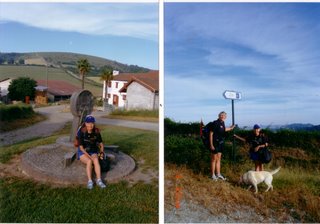
ost E24 for a lovely big room and hot bath. We were able to do our washing and sit in the sun with bare feet. Went to bed without supper.
8th June: The next day we attacked the Pass. It was a misty morning and the scenery was absolutely beautiful with valleys and waterfalls and green forests all the way! Joy did extremely well and even surprised herself by reaching the top without gasping or wheezing. When we finally saw the top of the pass after about 15km we hugged each other and asked someone to take our photos. We felt as though we had done Cowies Hill, Fields Hill, Botha’s Hill, Monteseel and Polly Shorts all in one go. There is a steep 1.5km downhill to Roncesvalles and we arrived there just after mid
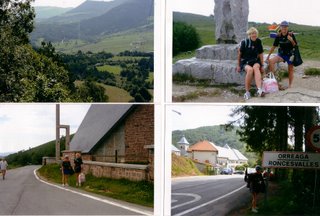
-day.
Roncesvalles is a monastery complex, not a village or town. There is the monastery, the church and old cloisters from the original church, a funery complex, which is supposed to contain hundreds of remains of soldiers who died fighting in the battle of Roland at the pass in 778, and the old church. We decided against staying in the pilgrim refuge and booked into the inn. We visited the museum and the cloisters. We were able to recharge our batteries and had a lovely rest there. At 7pm we had a Peregrino Menu for €7 in the din

ing room and we attended the pilgrim mass at 8pm. We felt quite emotional when the priest read out the names of the countries from which the pilgrims had come, including Sudafrica.
9th June: We caught the Lamontanesa bus at 6h45 to Pamplona which took about 1½ hours. We booked into the La Perla Hotel. We took a walk into the new part of town to see where Europe Car was. Joy wasn’t feeling well so we went back to the hotel so that she could lie down. I found the same little Internet café that I did two years ago when I was here with Clare and Georgette. In the afternoon we sat in the square and had lunch, a proper sandwich for a change, then walked around the old town, took pictures at the Rua Antigua and at the Porta Santiago. In the evening we sat in the square and had tapas, tortilla, gherkins, pickled onions and olives and a drink. The square was very noisy that night and we could hardly sleep.
10th June: We walked downtown to the Hotel

Bianco Navarre and had a hot chocolate at the hotel. We collected the car, an Ibiza, and decided that Joy should drive and I would navigate. It was quite hard to negotiate our way out of the traffic and onto the national road. Joy wrote home: “It was a bit nerve wracking but I had a good navigator. I felt a bit shattered at the end of the day because Sylvia kept screaming every time I got too close to anything on the right. Driving a left hand drive car on the right side of the road is quite hard to adjust to especially when going around circles and I had a few motorists hoot at us but nothing serious – we just kept going around until Sylvia managed to read the road signs! We didn’t get lost and we didn’t have to ask the way even once. The car is air-conditioned, which is just as well as it was 35oC today.”
We stopped at Estella and visited some of the churches but most were closed for renovations. We also stopped at Santo Domingo to see the live chickens in the church but that was also closed so we watched the storks in their nests instead. There must have been about 8 large nests and the babies sat waiting for their parents to bring them food making a clacking sound with their beaks. Our next stop was Burgos. When we got to Burgos Joy needed the loo and we were directed to a portable, public loo on the corner of the street. You have to insert 0,3E but Joy thought it was ,03 and so the door wouldn’t open. I then put in 3c and tried to pull the do

or open. It made a clicking sound and trapped both my hands in the door. A German fellow passing by was most concerned and shouted to his wife to call the police! He pressed on the door and tried to force it open and he tried inserting a 50c piece into the slot but the door stayed jammed on my fingers. Then I managed to get one hand free and put another 20c into the slot and the door finally opened freeing my hand and allowing Joy to have my long waited for wee! She was almost too frightened to use the thing in case the door never opened again. We had to leave Burgos in 5 o’clock traffic and if anyone had seen us whizzing around islands, crossing lanes going over the robot marks not knowing which was red they would have been proud of us!We spent that night in a little Spanish village called Castrojeriz. It is full of cobbled streets and is built on a hillside which is dominated by a ruined castle. Our room was beautiful in the "La Posada" with big 3/4 wooden beds, a full bathroom complete with a basket of goodies for the bath and - wait for it - A HAIRDRYER! What JOY for JOY! We had a meal at the Hostal el Meson which also owns the La Posada. It started raining so we couldn’t do any sightseeing but had an early night instead.11th June: We headed

for the Camino road and tried to find Hospital de Orbigo but ended up on the wrong road so we went straight to Leon instead. We visited the old quarter where there was a flea-market in progress. We went inside the cathedral and then drove on to Astorga, where we had lunch close to the Gaudi museum. From there we travelled to Ponferrada. In Ponferrada we thought we were completely lost so we stopped the car and I got out to ask someone the way to our hotel. We didn’t realise it but it was just around the corner. All we had to do was reverse the car and drive up a little side street. The Hostal Santa Cruz was in a very noisy area. We visited the Templar Castle and Camino info centre for our ´Sellos´(stamps). We sat in the square for a while and then had an early night.
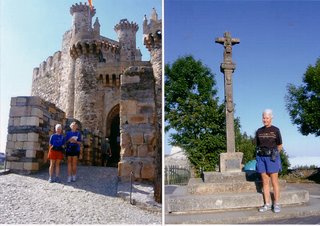
12th June: Today we drove on the Camino route to the mountain village of O´Cebriero where we had breakfast. It ALWAYS rains in O´Cebriero but the sun was shining and we got some nice photos. There was thick mist going back down into the valleys but Joy-Schumie took the bends like a pro.

We arrived on time in Lugo where we dropped off the little car -which we had named NODDY - and we walked the 3km back into the old city which is encircled by the most well preserved Roman walls in Spain. We had lunch at the station – a really great meal and inexpensive too. From there we took a bus to Sarria and found our hotel, the Hostal Roma quite close to the bus station. We walked into the town and got our passports stamped at the Camino office. Found a little supermarket where we bought provisions for the next day.

13th June: We were both a little apprehensive after having had 4 days rest from the back-packs but we plastered the toes and feet, re-packed the back packs and left the hotel just before sunrise and, meting up with other pilgrims, followed the Camino through green ´corriedors´ through fields and around low stonewalls surrounding subsistence farms - there is a strong Celtic influence here and it looks very much like parts of England. The route was up and down hills but the downs were worse than the ups as the paths are gravel or loose sand and one feels a little top heavy and unsteady on the feet negotiating the stony, gravel down hills. When we got to Portomarin we thought we might book into the Youth Hostel instead of the albergue but after waiting outside for almost an hour, we were told that it wasn’t open anymore. We then moved up the hill and stayed in a large modern albergue with hot showers and a large kitchen. We had lunch at a nearby café-bar and visited the church of St Nicholas which has a portal done by master Mateo. Met a young lady with tendonitis so massage one foot and leg each with Arnica. She told us we were angels. .Made ourselves cup-of-soup for supper and got to bed early.
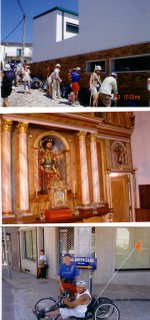
14th June: Left at about 6h15 and walked about 30kms (over familiar ground for me) through Ligonde and Eirexe to Cassanova. We bought food in Palas del Rei. In Cassanova we stopped at a small albergue that sleeps about 40 pilgrims. Carmen came along to open for us and we washed our clothes and sat in the sun chatting to Jay and Cheryl. Had soup and bread again for supper.
15th June: The terrain was fairly hilly today with ‘Kloof’ type hills, and we arrived in Arzua at about 11h30. The albergue wasn’t open so we left our packs outside and found a little bar across the road to have a cold drink. Booked to have lunch at 1pm – I needed vegetables. The café-bar had an Internet machine so I sent a message home. We had lunch and then explored the town. I met a man in a wheelchair who was doing day number 30 of his pilgrimage from Pamplona. His wife, also disabled, was following him in a camper. They ended up parking outside the albergue so that they could use the facilities.
16th June: Left at 6h15 - only a 23km today through beautiful forests and farms. We were the first to arrive at the albergue at 10h45 so we sat on the bench and the pilgrims started arriving in a never-ending stream. There was a little supermarket next door so I bought ready to cook

pasta, salad ingredients and soft rolls. Soon there were packs in a long line all the way along the front of the albergue and up the driveway. I noticed that everyone had pilgrim tans – white feet but bronzed legs and arms. Joy and I chatted to Elsabet from Denmark and Cheryl from Canada. I cooked the pasta and sauce and made a salad and we invited Elsabet to sha
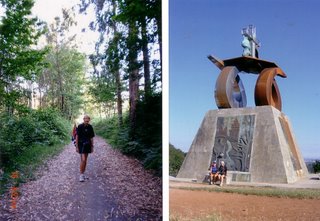
re our dinner with us. This albergue could sleep over 100 pilgrims and had stables for 8 horses. It was a very noisy night and didn’t get to sleep till after 11pm.
17th June: It was still dark when we left the albergue at about 6h15. The arrows led us down the main street and then into the forest again. We stopped for a hot chocolate and a sello at the halfway mark and then continued to Santiago. Once we were out of the forest we could see the Santiago skyline with TV masts, interchanging highways and high-rise buildings. There was a lot of road works going on and it was difficult to get excited about entering the city of the Saint whilst negotiating broken pavements and dug up roads.

Finally we entered the old part of the city and I led Joy to the Square and the front of the cathedral. We went to the Casa Dean to get our passports stamped and to get our Compostelas, certificates of completion in Latin. (My name is Silvian and Joy is Josepham) so besides all her other names she now has another new one! Then we found our Hostal Pazo Agra and settled in before going back to the cathedral to attend the 12 o’clock mass. The cathedral was packed and we had to sit on the floor. The botafemurio was swung across the aisle. We did all the traditional things like hug the saint and descend into the crypt to look at the silver casket that contains his remains. Then we left the cathedral and had lunch at a sidewalk café just off the square. Said goodbye to the father and son from Holland. Then we started shopping for souvenirs. Bought yoghurt for supper and got to bed at 10pm.
18th June: What a noisy night! People partied and shouted until 4 in the morning. We slept in until 8am. Walked around the new town and had lunch at a Pizza place. Not very efficient – they forgot Joy’s order and she had to wait almost an hour for her food. I put my photos on a disc and then we went to an exhibition in the park on the way back to the old town. Saw Cheryl and made arrangements to meet at the taxi rank in the morning and share a taxi to the airport. Had chips, chocolate, cheese and coffee for dinner.
19th June: Up at 8am and walked around the fresh food market. Checked out of the hotel and said goodbye to the owner. Met Cheryl and we got a taxi to the airport. Had lunch at the airport and then got our flight at 6pm to Barajas, Madrid. Had a boring 5hr wait at the airport and then our flight was delayed for an hour while we were on the runway.
20th June: Arrived in Jhb at 11am and was delighted to find Patty there to meet us. Had a sandwich at the airport and then we got our flight to Durban. We were both Sooooo pleased to see our families again and to hear Hip-Hop music blaring from the FM radio in a taxi parked at the loading bay outside! Home sweet home!

Highs and Lows? Always difficult to list but here are a few:
Lows:
*Sore shoulders and feet.
*Getting lost and you can't understand people's directions
*When someone says "It's not far" and they really mean by car
*Getting the wrong food 'cos you can't read the menu properly
*Long flights of stairs to climb to your room after a long, hard walk
*Noisy streets outside your bedroom at night when you are trying to sleep
*Stifling heat after mid-day when you still have two hours walking to do
*Compeed plaster going soft and sticking to your socks
Spain: *Pebble paths and uneven tracks
*Cow shit (especially those with diarrhoea)
*The sound of plastic packets at 4.30am when you are trying to sleep.
Highs:
*Walking - walking - walking, like a homeless vagabond - every day a new place.
*The wild flowers - poppies, white lace, foxgloves, yellow daisies, cornflowers, thistles etc etc etc from Paris all the way to Santiago. Just beautiful!
*Early morning sunrises and our long shadows on the road
France: *Changing scenery from following the River Loire for a week, the wheat fields for a week, vineyards for a week, three days of forests in the Landes and the mountains in the Pyrenees.
*The many people who helped us along the way especially Sister Theresa who, when seeing us St Vincent de Paul clapped her hands and called "Pelerins! Oh, pelerins! I must get you coffee. You must sleep here tonight." (We were moving on but she was a real highlight!)
*Reaching the Ibeneta Pass between France and Spain and feeling SO proud of Joy that she had made it without too much

gasping or heavy breathing!

Spain: *Wide vistas from Pamplona, the wheat fields of the Meseta, the mountains of Leon and the undulating rural countryside of Galicia.
*The incredible trust people have for each other. We slept in hotels where the owners were away but they gave us the access code for the front door, told us where the key to our room would be and we left the money behind the desk for them.
Spain: *Walking the Camino and meeting so many interesting people.
*The large white stork nests on top of almost every church with babies waiting for their parents to return with food
*Being able to do a foot massage or shoulder massage for a tired pilgrim.
*Reaching Santiago and attending the Pilgrim's mass.
For Sylvia: *Joy's sense of humour. Sometimes we giggled till we cried - usually at night when we were tired anyway and everything was so much funnier.
We both borrowed our son's digital cameras and did our best to take decent photos along the way so we have a good record of our journey through France and Spain.
Some of the resources we used to plan the walk:
1 & 2 Paris City Guide and Paris to the Pyrenees. Available from the CSJ-UK. www.csj.org.uk
3.
cranleigh@northnet.com.au Mary Wilkie’s Book on her walk in 1998
4.
http://www.philippe@doph.net/ Philippe Du Ngoc
5.
http://www.federal-hotel.com/ Federal Hotels
6.
http://www.logis-de-france.fr/ Logis Hotels


 ARILLAS ONCE AGAIN.
ARILLAS ONCE AGAIN.  videos, DVD, maps, brochures and posters, we have also hosted the annual St James Feast Day celebrations at ou
videos, DVD, maps, brochures and posters, we have also hosted the annual St James Feast Day celebrations at ou r home on or about the 25th July. I am SO thrilled that he will be able share a small part of the camino experience with me.
r home on or about the 25th July. I am SO thrilled that he will be able share a small part of the camino experience with me.




